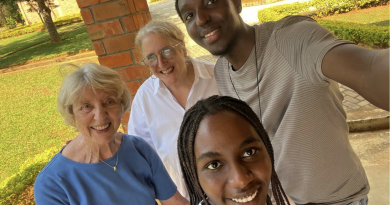Rwanda Makerspace Consortium Ignites Innovation Through Competition
In July, the Rwanda Makerspace Consortium hosted the competition “Our Future Green Village.” The competition provided inspiration for newly established maker clubs and an opportunity for students to showcase their maker skills and creativity.
All twenty schools in the Makerspace Consortium participated in the competition. Each maker club began by identifying environmental issues in their communities and brainstormed solutions. For example, one club decided to address the issue of land shortage in their village, which had a lot of houses. They decided to build skyscrapers and buildings with multiple levels. Another team addressed water issues by building a smart irrigation system around their school’s garden. Another team recognized that soap was very expensive and found ways to make their own soap from inexpensive materials.
On July 1, students packed their models on buses and headed to the Maranyundo Girls School. Some traveled from schools that were five hours away. The busloads of students began arriving in the morning. Students immediately began setting up their exhibits in the main hall. Each group proudly displayed their projects, with some even spilling onto the floor due to their sheer size and complexity. The room was energized as the students were excited and proud to present their work.
The students have created wonders.
Maranyundo Girls School Headmistress Sr. Laetitia Musanabaganwa
As the teams set up their exhibits, guests and judges arrived. Over 300 people gathered including students, teachers, heads of schools, and special guests.. A panel of six judges who each specialize in engineering education went from table to table and each group gave an enthusiastic presentation about their project. Judges assessed each project based on specific criteria:
- Inquiry/Thinking: Did the project address a community issue related to the theme?
- Design: How resourceful and innovative was the project? Did it exhibit teamwork and critical thinking?
- Community Impact: Would the project benefit the community in a practical way?
- Aesthetics and Cleanliness: How visually appealing was the project?
- Concept Presentation: How effectively did the team communicate to the audience?
As the judges deliberated, the celebration continued as students from Maranyundo Girls School entertained the audience with a traditional dance and chorus. Interviews with teachers and students followed the dance. They shared their experiences with making as a form of teaching and learning.
Finally, the judges announced the winners, awarding tablets to the top three secondary schools and the top three primary schools. The overall winner designed a modern village where all the houses and the hospital run on solar electricity. Motion and ultrasonic sensors control the power in houses, and the garden has a smart irrigation system. The winners took home a 3-D printer as the grand prize! Schools whose projects didn’t clinch a top spots still received materials for their maker space clubs, ensuring that students have the supplies they need to continue making.
The Rwanda Makerspace Consortium’s competition, “Our Future Green Village,” not only showcased the incredible innovation and creativity of students from twenty participating schools but also ignited a spirit of problem-solving and collaboration. This event celebrated the accomplishments of the winning projects but also highlighted the potential of makerspaces to inspire and empower students to find solutions to real-world challenges within their communities.



